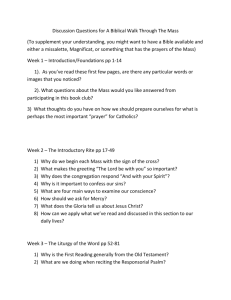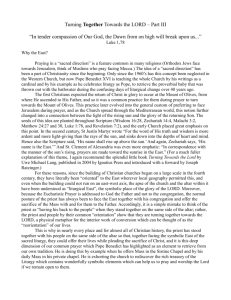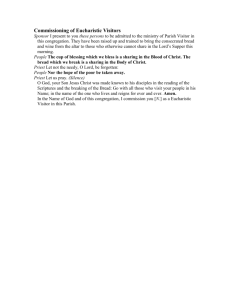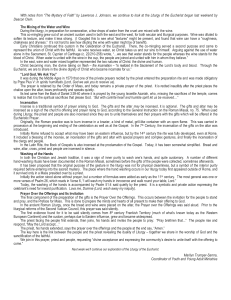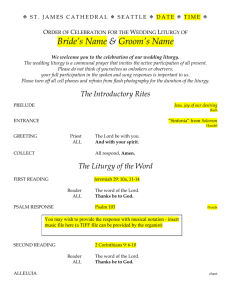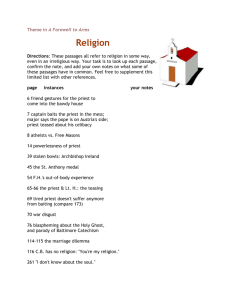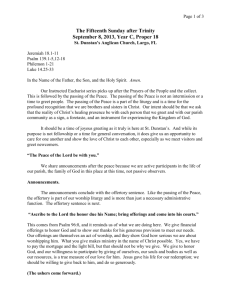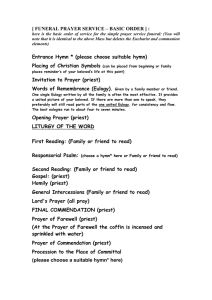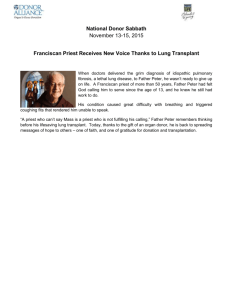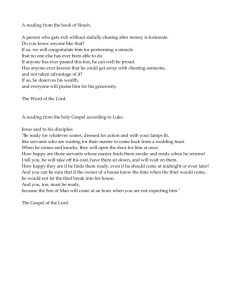Parts of the Mass Powerpoint
advertisement
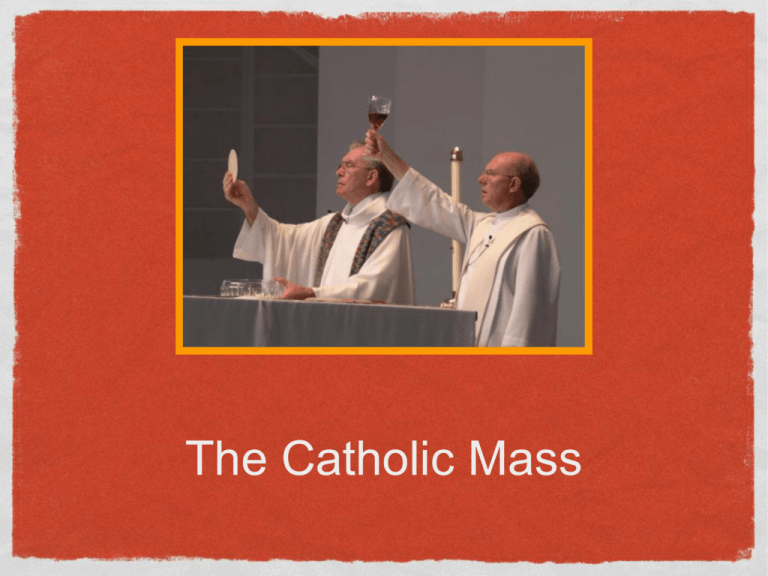
The Catholic Mass Mass is Based On Jesus’ Last Supper IMPORTANT VOCABULARY! •Priest: An ordained minister in the Catholic Church who has the authority to oversee the celebration of certain sacraments (including the Eucharist) •Rite: A religious ritual •Congregation: A group of people who are assembled for religious worship •Liturgy: The official ritual worship of the Church Parts of the Mass There are two main parts of the Mass: The Liturgy of the Word The part of the Mass when we read Scripture The Liturgy of the Eucharist The part of the Mass when we receive the body and blood of Christ. Parts of the Mass These two main parts are framed by two other rites: The Gathering Rites The Concluding Rite Parts of the Mass • Which means that there are 4 parts altogether: 1 Liturgy of the Word Liturgy of the Eucharist 2 3 4 The GATHERING Rites Entrance Procession: The priest enters the Church from the back, reverencing the altar (everyone bows; the priest kisses the altar). The Congregation stands and remains standing throughout the gathering rites. Greeting (the priest says a few words) Penitential Rite Sometimes we say the Confiteor (“I confess to Almighty God…”) We always say the Kyrie (“Lord, have mercy”) After the Gloria (which is a hymn of praise to God) the Priest leads the congregation in an Opening Prayer by saying, “Let us pray…” This is followed by a brief period of silence, followed by an Opening Prayer recited by the Priest (this prayer is different at every Mass). After the Opening Prayer, everybody sits. The Opening Prayer leads us directly into the first MAJOR part of the Mass…the Liturgy of the Word. IMPORTANT VOCABULARY! •Old Testament: Also called the Hebrew Scriptures. The stories of the Jewish people (remember, Jesus was Jewish, and so these stories are very important for Christians as well). •Psalms: Poetic prayers that are part of the Old Testament. •New Testament: The Christian Scriptures, including stories about Jesus’ life, the letters of St. Paul, etc. The stories about Jesus’ life, death and resurrection that are part of the New Testament. •Gospel: Liturgy of the Word During a typical Sunday Mass there are 3 readings. The first reading comes from the Old Testament. Reflects the continuity between Israel and Jesus, who came to fulfill the promises made by God to Israel. Following the first reading, there is a Responsorial Psalm, typically set to music. Liturgy of the Word The second reading is from the New Testament. Usually from one of the epistles (letters) in the New Testament. Response to both the first and second readings: “Thanks be to God” After the second reading, we STAND and sing “Alleluia!” It heralds (or welcomes) the Gospel reading, which comes next. Alleluia! “Alleluia” means “Praise the Lord!” During the Alleluia, the Priest raises the Gospel. This introduces the most important part of the Liturgy of the Word. During Lent, we never say “Alleluia,” because it is an exclamation of praise to the Risen Lord. The Gospel Reading PRIEST: “The Lord be with you” RESPONSE: “And also with you.” PRIEST: “A reading from the Holy Gospel according to…” RESPONSE: (While making the sign of the cross on your forehead, lips and heart) “Glory to you, Oh Lord” READING by the PRIEST PRIEST: “The Gospel of the Lord” RESPONSE: “Praise to you Lord Jesus Christ” Profession of Faith Following the Homily, the congregation stands and recites the Nicene Creed. “We believe in one God…” The Nicene Creed summarizes everything that the Church has taught for the past 2,000 years. General Intercessions From the chair, the priest invites the people to pray. LECTOR: “…let us pray to the Lord.” RESPONSE: “Lord, hear our prayer.” Repeated after each prayer petition. IMPORTANT VOCABULARY! •Altar: The place of sacrifice, as well as the table from which Christians are fed. It is the central focus of the Liturgy of the Eucharist. Liturgy of the Eucharist The second major part of the Mass. The Liturgy of the Word focuses on Scripture, but the Liturgy of the Eucharist focuses on the altar. Preparation of the Altar The gifts of bread and wine are placed at the back of the church before the service. Collection basket is passed around; sign of support for the ministry of the church. In procession, people bring the gifts (bread and wine) forward to the priest. This is called the offertory procession. This act echoes offerings of early church, when people would bring the bread and wine (and other stuff) they made in preparation for the Lord’s Supper. 1. TAKEN 2. BLESSED 3. BROKEN 4. GIVEN Priest accepting the gifts of the community that are brought forth IMPORTANT VOCABULARY! •Paten: A small plate, usually made out of silver or gold, used to hold Body of Christ (the consecrated bread). •Chalice: A standing cup, usually made out of silver or gold, used to hold the Blood of Christ (the consecrated wine). Preparation of the Gifts Priest pours the wine into the chalice, and adds a few drops of water, symbolizing the union of the humanity and divinity of Christ. When he receives the gifts, the priest recites prayers based on those used during the Jewish Passover meal. The priest lifts the paten of bread above the altar. PRIEST: “Blessed are you, Lord God of all creation, through your goodness…” The priest does the same thing with the chalice of wine. Eucharistic Prayer After washing his hands the priest invites the community to prepare for the Eucharist with him. o The Preface Dialogue (“…Lift up your hearts…”) The Sanctus (Holy, holy, holy) The community prays the prayer to Christ from the Book of Revelation The priest then chooses one of several Eucharistic Prayers to recount the story of the Last Supper The Consecration During the Liturgy of the Eucharist, the priest is acting in persona Christi (as the person of Christ). At the moment of the consecration, the priest is Jesus. The priest takes the paten and says, “This is my body…” Then he elevates the host for the congregation to see, and genuflects in front of the altar. He takes the chalice and says, “This is the cup of My Blood” Eucharist as the presence of God When the bread and wine are consecrated by the priest, they are transformed into Jesus’ body and blood. Therefore, this is THE MOST SACRED part of the Mass. This transformation is called Transubstantiation. The Eucharist is the most personal encounter with God. 1. TAKEN Priest accepting the gifts of the community that are brought forth 2. BLESSED The consecration of the bread and wine during the Eucharistic Prayer 3. BROKEN 4. GIVEN After the Consecration The community recites together the Memorial Acclamation (“Christ has died…” is the most common) Prayers for the entire Church, now joined together as one through the Eucharist, are spoken. The Eucharistic Prayer ends with a Doxology (“Through him, with him, in him…) Community responds with a Great Amen (“I believe!”) Communion Rite The Communion Rite opens in the model of Jesus with the Lord’s Prayer. While holding hands, we either sing or recite the Lord’s Prayer (“Our Father…”). The Lord’s Prayer is followed by the Sign of Peace. Sign of peace was once used to resolve conflicts with a neighbor before receiving the Eucharist Breaking of the Bread The priest breaks the bread and prepares the Eucharist for the Communion procession. Congregation recites the Agnus Dei or “Lamb of God,” recalling the Passover sacrifice of a lamb to save the life of God’s people Priest holds up consecrated bread and wine to the congregation, who publically declares its unworthiness to receive it (“Lord, I am not worthy…) 1. TAKEN Priest accepting the gifts of the community that are brought forth 2. BLESSED The consecration of the bread and wine during the Eucharistic Prayer 3. BROKEN The breaking of the bread by the priest, following the sign of peace 4. GIVEN The Communion Procession Priest or Extraordinary Minister: “The Body of Christ” RESPONSE: “Amen” Saying “Amen” is another way of saying “Yes, I believe that this is truly the Body of Christ.” After receiving Holy Communion, we go back to the pew, kneel (or sit) and pray silently for a few minutes, or sing the Communion song 1. TAKEN Priest accepting the gifts of the community that are brought forth 2. BLESSED The consecration of the bread and wine during the Eucharistic Prayer 3. BROKEN The breaking of the bread by the priest, following the sign of peace 4. GIVEN The Communion Procession Who May Receive Communion? Who should not receive Communion? Non-Catholics Catholics who have not fasted prior to Communion Catholics who haven’t made their First Confession and First Communion. Bread and Wine Bread and Wine are the two species of Eucharist Usually everyone takes the bread The wine is optional Wine was once reserved for those celebrating and helping Wine is sometimes not offered for practical reasons Some parishes allow you to dip host in wine Concluding Rite and Dismissal After a closing prayer, the priest blesses and dismisses the people The name “Mass” comes from the Latin Ite, missa est (roughly translated as “Go, you are sent forth”), the priest’s final words “Go in peace, to love and serve the Lord and one another” The Community united by Eucharist is called to be a community OUTSIDE of the Mass.
